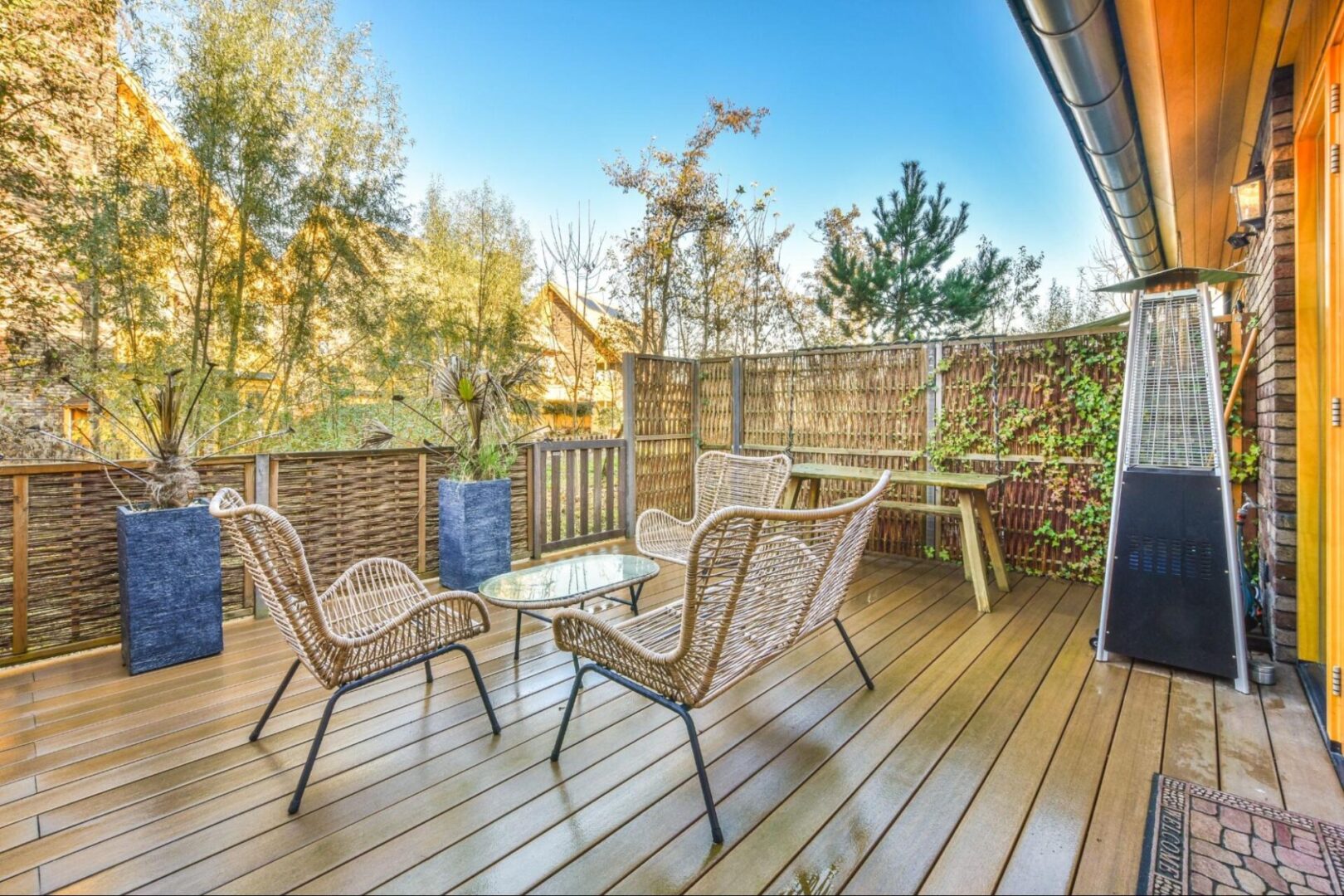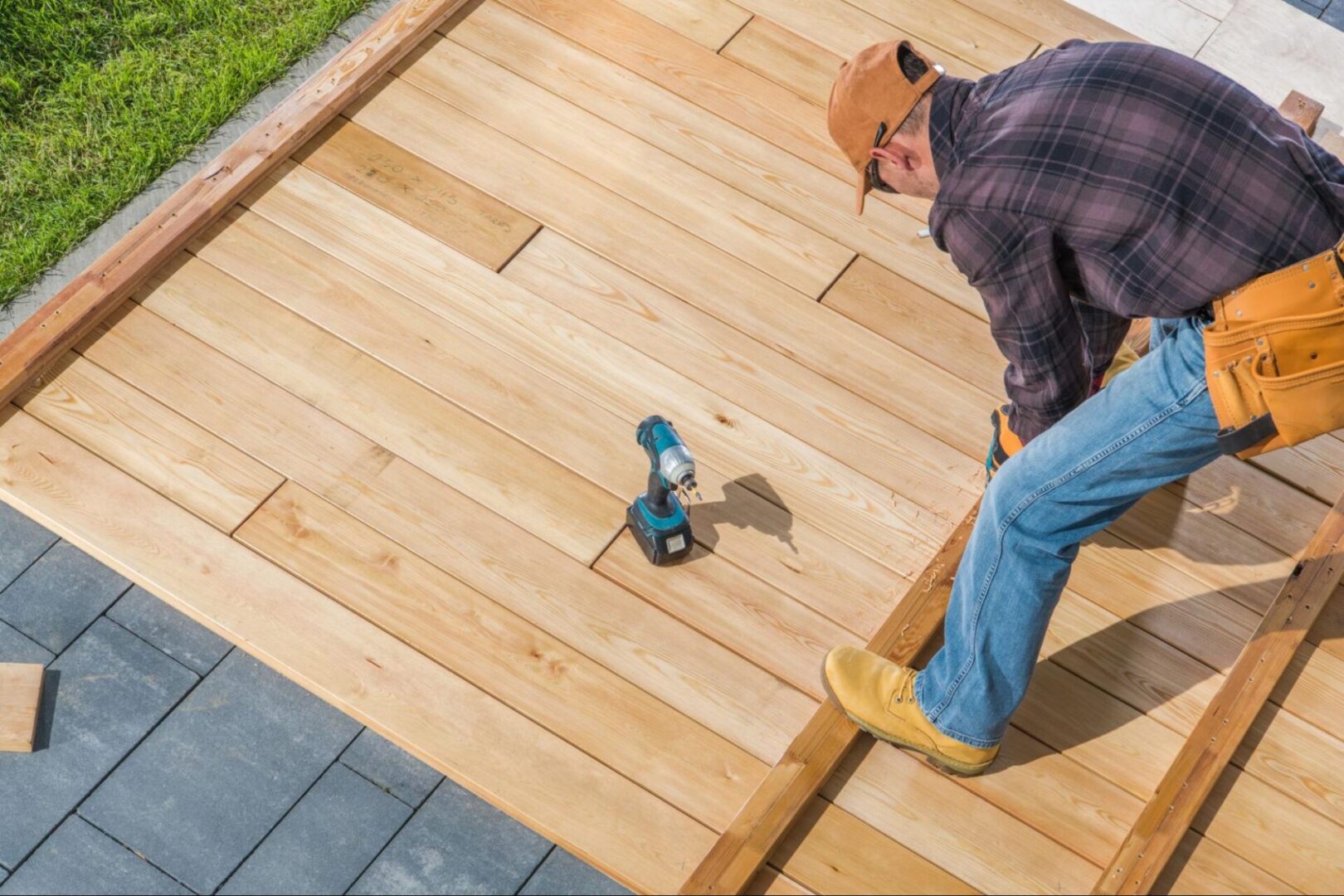
Choosing the right deck material starts with creating a well-designed and durable deck and fence for your outdoor space. With various materials available today, homeowners have endless possibilities for crafting modern outdoor spaces that balance functionality, aesthetics, and sustainability. Let’s delve into the latest trends in deck materials, offering insights and inspiration to help you craft a modern outdoor space that blends functionality, aesthetics, and sustainability.
Deck Materials for Modern Outdoor Spaces
Modern outdoor spaces are becoming more than just functional areas—they are personal retreats, entertaining hubs, and aesthetic highlights of a property. Choosing the right deck material impacts the durability and look of your space and aligns with trends in sustainability and innovation.
Wood Decking: The Timeless Classic
Wood decking has long been favored for its natural charm and versatility. Options like pressure-treated lumber offer affordability and resistance to pests and rot, while cedar and redwood boast rich colors and natural decay resistance. Exotic hardwoods, such as ipe or teak, combine stunning aesthetics with unmatched durability. While wood decking requires regular maintenance, like staining and sealing, its enduring appeal continues to make it a top choice for many homeowners.
Composite Decking: A Modern Favorite
Composite decking has emerged as a go-to solution for contemporary outdoor spaces. Crafted from wood fibers and recycled plastics, it provides a durable, low-maintenance option that resists rot, mold, and insect damage. With eco-friendly production and various colors and textures that mimic natural wood, composite decking combines practicality with modern aesthetics, making it a smart choice for sustainable living.
PVC Decking: Lightweight and Resilient
Made entirely from synthetic materials, PVC decking is perfect for homeowners seeking an ultra-low-maintenance option. Its water resistance makes it ideal for areas exposed to moisture, such as pool decks, while its UV resistance ensures vibrant color retention. Lightweight yet durable, PVC decking prioritizes functionality and ease of installation, appealing to those who value efficiency and performance over a natural wood appearance.
Aluminum Decking: The Durable Trendsetter
Aluminum decking is a standout choice for industrial strength and longevity. This material is known for its corrosion resistance. Thus, it performs well in extreme weather conditions and provides excellent slip resistance, making it safe for families and poolside areas. Additionally, aluminum is recyclable, supporting eco-friendly practices. Though its higher cost makes it less common, its sleek, modern look and durability make it a worthwhile investment.
Sustainable Decking Materials for Eco-Friendly Living
Eco-conscious homeowners are adopting sustainable decking options to align with green building trends. Bamboo decking, a rapidly renewable resource, offers a sleek and modern aesthetic, while recycled plastic decking repurposes waste into durable, weather-resistant boards. Reclaimed wood combines the character of natural materials with environmental responsibility. These options reduce a project’s carbon footprint and add unique character and style to outdoor spaces.

Budget-Friendly Deck Material Trends for Outdoor Space
Designing a stunning outdoor space is achievable even on a budget without compromising quality or aesthetics. Choosing cost-effective options lets you enjoy a functional and stylish deck that aligns with modern trends. Here are some affordable deck materials to consider for your project:
Pallet Wood Decking
Using reclaimed pallet wood is a budget-friendly option for DIY projects. While preparing requires more labor, it delivers a rustic and unique look. Proper treatment and sealing are essential to ensure durability.
Cedar Decking
Cedar is slightly more expensive than pressure-treated lumber but remains affordable compared to exotic hardwoods. Its natural resistance to rot and insects reduces the need for chemical treatments, offering a cost-effective yet attractive decking option.
These materials allow you to create a modern outdoor space while staying within budget, proving that style and functionality don’t always require a high price tag.
Concrete Decking
Concrete offers a budget-friendly solution for building durable and low-maintenance outdoor spaces. With modern stamping and staining techniques, you can mimic the appearance of more expensive materials like stone or wood at a fraction of the cost.
Vinyl Decking
Vinyl decking is an economical alternative to PVC. It provides a lightweight and durable material for outdoor spaces. It’s also resistant to moisture and pests, making it a low-maintenance option for those on a budget.
Softwood Decking
Softwoods such as pine and spruce are affordable and widely available. Although they require regular maintenance to protect against weathering, their low initial cost makes them an appealing choice for budget-conscious homeowners.
Gravel Decking With Wooden Frames
For a creative and cost-effective approach, combine gravel as the primary surface material with simple wooden frames for structure. This hybrid design reduces material costs while offering a unique, modern aesthetic for outdoor spaces.
Innovations in Deck Material Technology
Modern outdoor spaces are evolving with cutting-edge advancements in deck material technology. Homeowners can now access materials combining aesthetics, durability, and functionality to create personalized, future-ready designs. These innovations are not just about looks—they enhance safety, sustainability, and outdoor living experiences.
Smart Deck Materials
Smart technology is revolutionizing modern outdoor spaces by integrating convenience and innovation. Composite materials now feature solar panels that generate energy for outdoor lighting or appliances, seamlessly blending sustainability with functionality. Additionally, LED lighting systems built into the deck provide a sleek and modern ambiance, enhancing aesthetics and usability at night.
Weather-Resistant Coatings
Weather-resistant coatings are essential for maintaining the elegance and longevity of modern outdoor spaces. These advanced finishes protect decks from the damaging effects of sun, rain, and snow, ensuring they remain vibrant and structurally sound. By reducing maintenance needs, these coatings allow homeowners to focus on enjoying their outdoor areas without constant upkeep.
Anti-Slip Technology
Safety and sophistication go hand in hand with the latest anti-slip technology for outdoor decks. Modern materials are designed with textured surfaces that maintain grip even in wet or icy conditions, providing a secure space for family and guests. This innovation ensures that functionality doesn’t compromise the sleek look of contemporary outdoor designs.
Emerging Trends
Personalization is a defining characteristic of modern outdoor spaces, and new trends in deck materials reflect this demand. Customizable textures, such as realistic woodgrain patterns, and a wide range of color finishes enable homeowners to design decks that align with their unique style. These emerging options highlight how outdoor spaces can be visually stunning and tailored for comfort and practicality.
Combining Deck Material Trends for Unique Outdoor Designs
A growing trend in modern outdoor spaces is the artful combination of different deck materials to create attractive designs. This approach not only enhances the visual appeal of your deck but also allows for greater customization and functionality. By mixing materials, you can balance aesthetics, practicality, and innovation. Below are some tips to make the most of this trend:
Mix Warm and Sleek Elements
Pair natural wood decking with aluminum accents like railings, pergolas, or frames for a balanced look. Wood’s warmth and organic feel contrast beautifully with aluminum’s sleek, industrial aesthetic. This combination creates a visually striking, modern outdoor design that blends rustic charm with contemporary sophistication.
Use Contrasting Textures
Combine composite decking with PVC to add a variety of textures to your deck. PVC’s smooth, glossy finish pairs perfectly with composite materials’ natural, matte look. This contrast enhances the deck’s visual appeal and provides a durable and functional surface for outdoor use.
Incorporate Glass or Metal Details
Add glass panels or metal fixtures to elevate the design of your outdoor space. Glass enhances openness and offers unobstructed views, while metal adds a modern and industrial touch. These elements seamlessly integrate with various deck materials, making them ideal for creating contemporary outdoor aesthetics.
Create Zones With Different Materials
Use different materials to define distinct areas of your outdoor space, such as wood for walkways and composite for seating areas. This approach adds visual interest while improving the deck’s functionality. It also allows you to create purpose-driven zones that cater to specific activities, such as dining or lounging.
Blend Colors Thoughtfully
Choose complementary colors when combining deck materials to ensure a harmonious design. For instance, gray composite decking pairs beautifully with black aluminum accents, while light-colored PVC works well with darker wood tones. Thoughtful color blending enhances the overall cohesiveness and elegance of your outdoor space.

Choosing the Best Deck Material for Outdoor Space
Modern outdoor spaces require thoughtful material choices to balance style, durability, and functionality. With evolving trends in deck materials, selecting the right option for your space involves considering climate, budget, and sustainability. A well-informed decision ensures your deck enhances your outdoor area and stands the test of time while reflecting your style and values.
Assessing Your Climate and Environment
Your area’s climate greatly influences your deck material’s performance and longevity. Composite or PVC decking is ideal for humid regions as it resists moisture and prevents issues like rot or mold. Sunny areas require UV-resistant materials to maintain their color and integrity over time, while cold climates benefit from aluminum or composite decking, which can withstand freeze-thaw cycles without cracking or warping.
Balancing Budget and Aesthetic Goals
Striking the right balance between cost and appearance is crucial when choosing your deck material. Wood decking provides unmatched natural beauty but demands consistent maintenance, which can increase expenses over time. In contrast, composite and PVC materials have higher initial costs but offer low-maintenance benefits, making them a cost-effective and stylish choice in the long run.
Considering Sustainability
Sustainable decking materials are a perfect choice for homeowners focused on eco-friendly living. Bamboo decking is a rapidly renewable resource, while recycled plastic decking repurposes waste into durable boards. These options marry environmental responsibility with modern aesthetics, allowing you to create an outdoor space that aligns with green building practices.
Embracing Deck Material Trends for Lasting Outdoor Spaces
Staying informed about deck material trends allows you to create a functional and visually stunning outdoor space. By understanding the maintenance needs of different materials and selecting the right options for your climate, budget, and sustainability goals, you can ensure your deck remains a beautiful and durable addition to your home. Whether you prefer the timeless charm of wood, the practicality of composite, or the eco-friendliness of recycled materials, keeping up with trends ensures your deck reflects modern design principles while standing the test of time.
Get inspired to redefine your outdoor living area by exploring innovative deck material trends. For more ideas, visit our Minnesota’s 1st Choice Replacement Windows and Doors blog.

